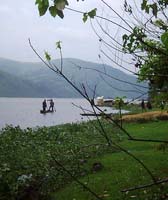Central African Republic
The Central African Republic is famed for its lowland gorilla population, Pygmy culture and for its fabulous national parks.
Ubangian peoples settled the region beginning in 1000 BC and, until the early 19th century, they remained beyond the reach of the expanding Islam movement.
In the 1800's, however, the Pygmy population was all but decimated by the slave trade. The French (to their credit) were anti-slavery, and began to take control of this land in 1905 by establishing the colony of Ubangi-Chair.
The rulers of Ubangi-Shari took advantage of the Frenchin an effort to gain more weapons, which were then used to apprehend additional slaves, and, in general, made life miserable for the citizens lacking power to resist.
Cotton, tea and coffee surfaced in the 1930s as a major cash crop, with several companies monopolizing on the products.
In the 1940's, amidst World War II, the region became aFrench overseas territory, and then finally gained its independence from France in 1958.
From 1965 to 1979, the country suffered through the dictatorial reign of Colonel Jean-Bedel Bokassa. A series of military coups followed, with multiparty elections finally being held in 1993.
The results of those elections saw Ange-Felix Patasse secure a victory as the Central African Republic's new president, and the following year a new constitution was approved.
Several rebellions against the Patasse regime occurred in the years following the elections, and economic difficulties, an energy crises, and government mismanagement plagued Patasse's government until his departure from office in 2003.
General Francois Bozize was appointed president in the wake of Patasse's removal, and since then the Central African Republic's government has remained somewhat stable.
 The country has the potential to be a major tourist destination, but, unfortunately, its poor infrastructure is a major preventative factor in that regard. However, for those who venture in (mostly Europeans), the pristine parks and wildlife are second to none, and hunting safaris (sadly) are still a big business.
The country has the potential to be a major tourist destination, but, unfortunately, its poor infrastructure is a major preventative factor in that regard. However, for those who venture in (mostly Europeans), the pristine parks and wildlife are second to none, and hunting safaris (sadly) are still a big business.
Those national parks are home to lions, leopards, rhinos, forest elephants and countless other animals. One of the lowland gorilla's last habitats is found in the rainforests of the south.
Due to consistent flooding, the land is lightly cultivated, and agriculture is mostly at the subsistence level. Diamond and Uranium mining, as well as timber harvesting remain important industries.
Within the Central African Republic, HIV/AIDS is still spreading, and the country is seriously afflicted by destabilizing financial and social problems.
Ubangian peoples settled the region beginning in 1000 BC and, until the early 19th century, they remained beyond the reach of the expanding Islam movement.
In the 1800's, however, the Pygmy population was all but decimated by the slave trade. The French (to their credit) were anti-slavery, and began to take control of this land in 1905 by establishing the colony of Ubangi-Chair.
The rulers of Ubangi-Shari took advantage of the Frenchin an effort to gain more weapons, which were then used to apprehend additional slaves, and, in general, made life miserable for the citizens lacking power to resist.
Cotton, tea and coffee surfaced in the 1930s as a major cash crop, with several companies monopolizing on the products.
In the 1940's, amidst World War II, the region became aFrench overseas territory, and then finally gained its independence from France in 1958.
From 1965 to 1979, the country suffered through the dictatorial reign of Colonel Jean-Bedel Bokassa. A series of military coups followed, with multiparty elections finally being held in 1993.
The results of those elections saw Ange-Felix Patasse secure a victory as the Central African Republic's new president, and the following year a new constitution was approved.
Several rebellions against the Patasse regime occurred in the years following the elections, and economic difficulties, an energy crises, and government mismanagement plagued Patasse's government until his departure from office in 2003.
General Francois Bozize was appointed president in the wake of Patasse's removal, and since then the Central African Republic's government has remained somewhat stable.
 The country has the potential to be a major tourist destination, but, unfortunately, its poor infrastructure is a major preventative factor in that regard. However, for those who venture in (mostly Europeans), the pristine parks and wildlife are second to none, and hunting safaris (sadly) are still a big business.
The country has the potential to be a major tourist destination, but, unfortunately, its poor infrastructure is a major preventative factor in that regard. However, for those who venture in (mostly Europeans), the pristine parks and wildlife are second to none, and hunting safaris (sadly) are still a big business. Those national parks are home to lions, leopards, rhinos, forest elephants and countless other animals. One of the lowland gorilla's last habitats is found in the rainforests of the south.
Due to consistent flooding, the land is lightly cultivated, and agriculture is mostly at the subsistence level. Diamond and Uranium mining, as well as timber harvesting remain important industries.
Within the Central African Republic, HIV/AIDS is still spreading, and the country is seriously afflicted by destabilizing financial and social problems.
No comments:
Post a Comment